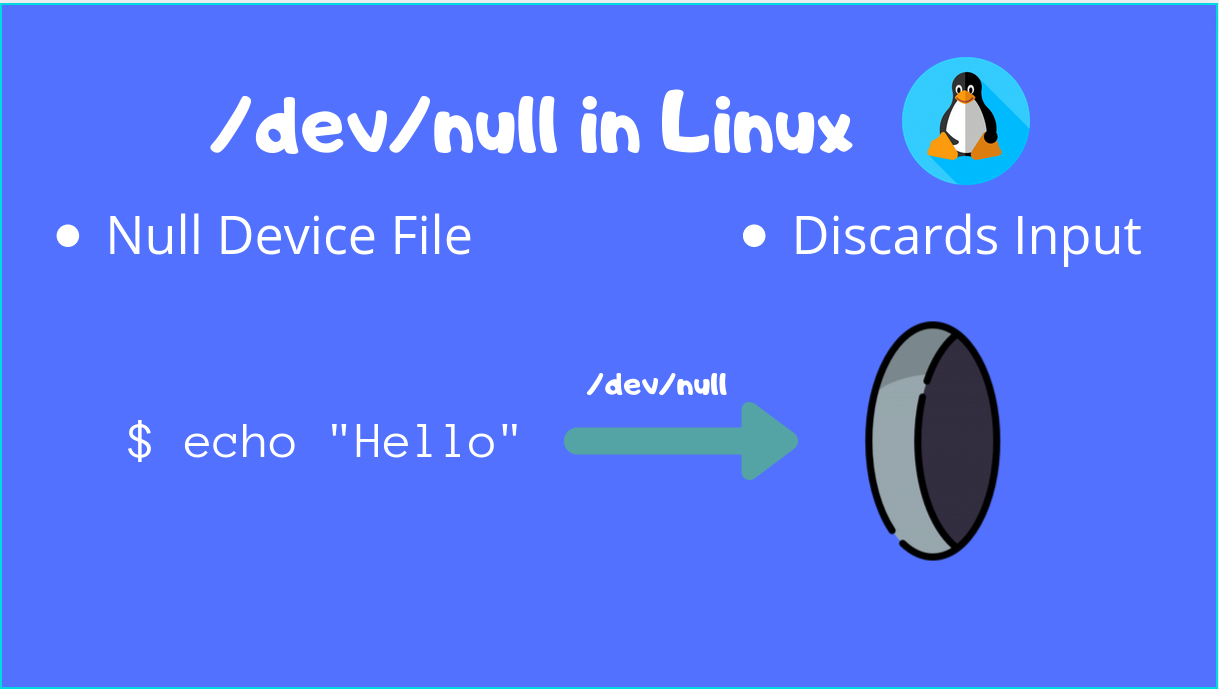- Log in to:
- Community
- DigitalOcean
- Sign up for:
- Community
- DigitalOcean

/dev/null in Linux is a null device file. This will discard anything written to it, and will return EOF on reading.
This is a command-line hack that acts as a vacuum, that sucks anything thrown to it.
Let’s take a look at understanding what it means, and what we can do with this file.
/dev/null Properties
This will return an End of File (EOF) character if you try to read it using the cat command.
cat /dev/null
This is a valid file, which can be verified using
stat /dev/null
This gives me an output of
File: /dev/null
Size: 0 Blocks: 0 IO Block: 4096 character special file
Device: 6h/6d Inode: 5 Links: 1 Device type: 1,3
Access: (0666/crw-rw-rw-) Uid: ( 0/ root) Gid: ( 0/ root)
Access: 2020-02-04 13:00:43.112464814 +0530
Modify: 2020-02-04 13:00:43.112464814 +0530
Change: 2020-02-04 13:00:43.112464814 +0530
This shows that this file has a size of 0 bytes, has zero blocks allocated to it. The file permissions are also set that anyone can read/write to it, but cannot execute it.
Since it is not an executable file, we cannot use piping using | operator to redirect to /dev/null. The only way is to use file redirections (>, >>, or <, <<).
The below diagram shows that /dev/null is indeed a valid file.

Let’s now take a look at some common use cases for /dev/null.
Redirection to /dev/null in Linux
We can discard any output of a script that we use by redirecting to /dev/null.
For example, we can try discarding echo messages using this trick.
echo 'Hello from JournalDev' > /dev/null
You will not get any output since it is discarded!
Let’s try running a command incorrectly and pipe it’s output to /dev/null.
cat --INCORRECT_OPTION > /dev/null
We still get an output like this:
cat: unrecognized option '--INCORRECT'
Try 'cat --help' for more information.
Why is this happening? This is because the error messages are coming from stderr, but we are only discarding output from stdout.
We need to take stderr into account as well.
Discard error messages
Let us redirect the stderr to /dev/null, along with stdout. We can use the file descriptor for stderr(=2) for this.
cat --INCORRECT_OPTION > /dev/null 2>/dev/null
This will give us what we need!
There is another way of doing the same; by redirecting stderr to stdout first, and then redirect stdout to /dev/null.
The syntax for this will be:
command > /dev/null 2>&1
Notice the 2>&1 at the end. We redirect stderr(2) to stdout(1). We use &1 to mention to the shell that the destination file is a file descriptor and not a file name.
cat --INCORRECT_OPTION > dev/null 2>&1
So if we use 2>1, we will only redirect stderr to a file called 1. This is not what we want!
Conclusion
Hopefully, this clears things up a bit, so that you can now use /dev/null in Linux, knowing what it means! Feel free to ask questions in the comment section below.
Thanks for learning with the DigitalOcean Community. Check out our offerings for compute, storage, networking, and managed databases.
About the author
Still looking for an answer?
How do I get the code to confirm devils.com.when I confirm it ask me for past code
- Cornell utley
Deploy on DigitalOcean
Click below to sign up for DigitalOcean's virtual machines, Databases, and AIML products.
Become a contributor for community
Get paid to write technical tutorials and select a tech-focused charity to receive a matching donation.
DigitalOcean Documentation
Full documentation for every DigitalOcean product.
Resources for startups and SMBs
The Wave has everything you need to know about building a business, from raising funding to marketing your product.
Get our newsletter
Stay up to date by signing up for DigitalOcean’s Infrastructure as a Newsletter.
New accounts only. By submitting your email you agree to our Privacy Policy
The developer cloud
Scale up as you grow — whether you're running one virtual machine or ten thousand.
Get started for free
Sign up and get $200 in credit for your first 60 days with DigitalOcean.*
*This promotional offer applies to new accounts only.
